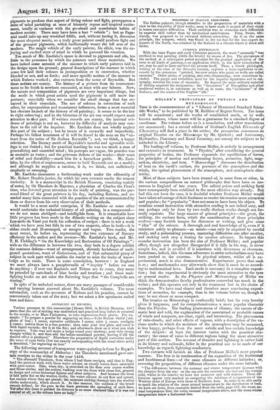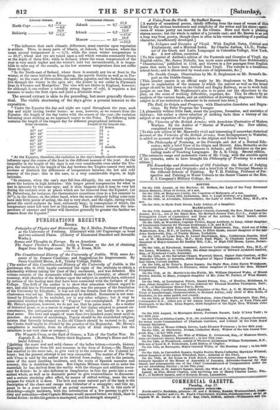Mil...ELBE'S PRINCIPLES OF PHYSICS AND METEOROLOGY.
THIS is the commencement of a " Library of Illustrated Standard Scien- tific Works," to be published by M. Bailliere of Regent Street. The issue will be occasional ; and the works of established merit, or by well- known authors, whose name will be a guarantee for a standard degree of excellence. The volume before us is a translation, and other translations are announced ; but a second edition of Graham's English Elements of Chemistry will find a place in the series; the prospectus announces an original Treatise on the Microscope by Mr. Quekett; and Astronomy, Hydraulics, Pharmacy and Rural Economy, are among the subjects to be' included in the Library.
The leading-off volume, by Professor Miller, is orderly in arrangement and extensive in treatment. In "Physics," after considering the general properties of bodies, the Professor expounds the equilibrium of forces, the principles of motion and accelerating forces, acoustics, light, mag- netism, electricity, and heat. " Meteorology " discusses the distribution of heat on the earth's surface, the pressure of the atmosphere and the winds, the optical phmnomena of the atmosphere, and atmospheric elec- tricity.
Most of these subjects have been treated of, in some form or other, in
the various compendiums on natural philosophy that have been so nu- merous in England of late years. The salient points and striking facts have consequently been exhibited in the most effective way already. But had this not been the case, it is doubtful whether Professor Muller would have taken advantage of their freshness to render his treatise more attractive and popular; for "popularity "does not seem to have been his object. To combine sound instruction with attractive reading is not indeed easy, and can perhaps only be done by two really distinct works though not for- mally separate. The large masses of general principles—the great, the striking, the curious facts, which the consideration of those principles evolves—may furnish images for discourse or writing, and give some "idea" of the science. A thorough and real knowledge of it, even if it ministers solely to pleasure—as music—can only be acquired by careful study, and a painstaking process, mastering difficulties one after another, and making each step a footing for another advance. To impart this sounder instruction has been the aim of Professor Miiller ; and popular effect, though not altogether disregarded if it falls in his way, is never sought for, and is avoided if it interferes with directness or closeness. Sometimes indeed, this German adherence to strict technicalities may have been pushed to the extreme. In physical science, whilst all is ex- perimental, much is also demonstrative. Experiments prove that such is so ; and mathematics may afterwards show that it must be so accord- ing to mathematical laws. Each mode is necessary in a complete exposi- tion; but the experimental is obviously the most attractive to the tyro or general reader. In the Physics and Meteorology of Muller we think the demonstrative faculty predominates somewhat too much in the writer ; and this operates not only in the treatment but in the choice of examples. We have read clearer and therefore more convincing exposi- tions of acoustics, for example, than in the volume before us, though it may be not closer or more compact.
The treatise on Meteorology is confessedly brief; but its very brevity
gives it largeness, and its comprehensiveness a more popular character than the Physics. The leading pluenomena of climate, the causes of cli- matic heat and cold, the explanation of the ascertained or probable causes of winds and tempests, are clear, rapid, and interesting. The phtenomena of rain-clouds, and other effects of vapour, with a description of the va- rious modes in which the moisture of the atmosphere may be measured, is less happy, perhaps from the more subtile and less certain knowledge of the subject : at least the interest varies with the practical cha- racter; the cause of rains in different regions being the most attractive part of this section. The account of thunder and lightning is rather bald in its history and rationale, fuller in the practical use to be made of our knowledge as regards lightning-conductors. Two extracts will furnish an idea of Professor Mfiller's more popular manner. The first is in continuation of the exposition of the Isothermal and Isochimenal lines—of the same climates at different latitudes; or, reversing the proposition, of different climates under the same latitude.
"The differences between the summer and winter temperature increase with the distance from the sea: on the sea-side the summers are cool and the winters mild, whilst in the interior we have hot summers and cold winters. These dif- ferences appear very marked on comparing the relations of temperature of the Western shore of Europe with those of Northern Asia. In order to be able easily to mark the relation of the mean annual temperature to the distribution of heat, we have set down, from examples derived from the table, page 507, the mean an- nual temperature first, the mean summer temperature aboverand the mean winter temperature below a horizontal line.
Littoral climate. Continental climate.
6.4
North Cape 0,1 Jakuzk - 9,7 17'2 -4,6 -38,9 Reikiavig 4,0 12.0 Irkur.k - 0,2 15'9
-17,6
Moscow - 3,6 16'8 -10,3 "The influence that such climatic differences must exercise upon vegetation is evident. Thus, in many parts of Siberia, at Jakuzk, for instance, where the mean annual temperature is - 9,70, while the mean winter temperature is - 38,9°, wheat and rye are raised upon a soil which remains constantly frozen at the depth of three feet; while in Iceland, where the mean temperature of the year is very much higher and the winter's cold but inconsiderable, it is impos- sible to raise any of the cereals, as the low summer temperature does not suffer them to ripen. " In the North-east of Ireland, where there is scarcely any ice or frost in the winter, at the same latitude as KOnigsberg, the myrtle thrives as well as in Por- tugal; on the coast of Devonshire, the camellia japonica and the fuchsia coccinea live through the winter in the open air; the winter is not colder in Plymouth than in Florence and Montpellier. The vine will not thrive in England, however; for although it can endure a tolerably strong degree of cold, it requires a hot summer to make the fruit ripen and yield a drinkable wine."
The second extract is akin to the preceding, but more generally theore- tical The visible shortening of the days gives a present interest to the exposition.
"Under the Equator the day and night are equal throughout the year, each day and night lasting twelve hours: as soon, however, as we remove from the Equator, the length of the day varies with the season of the year; the variation becoming more striking as we approach nearer to the Poles. The following table contains the length of the longest day for different geographical latitudes.
Polar elevation. Length of the longest day.
0 12 hours.
16° 44' 13 „
80° 481 14 „ 490 22' 16 „ 630 23' 20 „ 660 32' 24 „ 670 23' 1 month.
73° 39' 3 11
900 11
"At the Equator, therefore, the variation in the day's length cannot exercise any influence upon the course of the heat in the different seasons of the year. As the inequality in the length of the days is not very considerable even under the Tro- pics, the variation in the length of the day between the Tropics cannot very much increase or diminish the differences of temperature between the hot and cold seasons of the year: this is the case, to a very considerable degree, in high latitudes.
"In summer, when the sun's rays fall less obliquely, the sun remains longer above the horizon in high latitudes: this longer period compensates for what is lost in intensity by the solar rays; and it thus happens that it may be very hot during the summer even at places which are far removed from the Equator, (at St. Petersburg, for instance, the thermometer sometimes rises in a hot summer to 300); in the winter, on the other hand, when the more obliquely falling solar rays have only little power of acting, the day is very short, and the night, during which period the earth radiates its heat, extremely long; in consequence of which, the temperature must fall very low at this season. The difference between the tem- perature of summer and winter will therefore generally be greater the further we remove from the Equator."



























 Previous page
Previous page